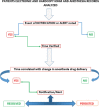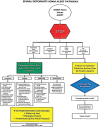Intraoperative neurophysiological monitoring team's communiqué with anesthesia professionals
- PMID: 29643629
- PMCID: PMC5885456
- DOI: 10.4103/joacp.JOACP_315_17
Intraoperative neurophysiological monitoring team's communiqué with anesthesia professionals
Abstract
Background and aims: Intraoperative neurophysiological monitoring (IONM) is the standard of care during many spinal, vascular, and intracranial surgeries. High-quality perioperative care requires the communication and cooperation of several multidisciplinary teams. One of these multidisciplinary services is intraoperative neuromonitoring (IONM), while other teams represent anesthesia and surgery. Few studies have investigated the IONM team's objective communication with anesthesia providers. We conducted a retrospective review of IONM-related quality assurance data to identify how changes in the evoked potentials observed during the surgery were communicated within our IONM-anesthesia team and determined the resulting qualitative outcomes.
Material and methods: Quality assurance records of 3,112 patients who underwent surgical procedures with IONM (from 2010 to 2015) were reviewed. We examined communications regarding perioperative evoked potential or electroencephalography (EEG) fluctuations that prompted neurophysiologists to alert/notify the anesthesia team to consider alteration of anesthetic depth/drug regimen or patient positioning and analyzed the outcomes of these interventions.
Results: Of the total of 1280 (41.13%) communications issued, there were 347 notifications and 11 alerts made by the neurophysiologist to the anesthesia team for various types of neuro/orthopedic surgeries. Prompt communication led to resolution of 90% of alerts and 80% of notifications after corrective measures were executed by the anesthesiologists. Notifications mainly related to limb malpositioning and extravasation of intravenous fluid.
Conclusion: Based on our institutions' protocol and algorithm for intervention during IONM-supported surgeries, our findings of resolution in alerts and notifications indicate that successful communications between the two teams could potentially lead to improved anesthetic care and patient safety.
Keywords: Anesthesia; communication; electroencephalography; electromyography; intraoperative neurophysiological monitoring; motor evoked potentials; patient safety; somatosensory evoked potentials; transcranial motor evoked potentials.
Conflict of interest statement
There are no conflicts of interest.
Figures




References
-
- Lall RR, Lall RR, Hauptman JS, Munoz C, Cybulski GR, Koski T, et al. Intraoperative neurophysiological monitoring in spine surgery: Indications, efficacy, and role of the preoperative checklist. Neurosurg Focus. 2012;33:E10. - PubMed
-
- Macdonald DB, Skinner S, Shils J, Yingling C American Society of Neurophysiological. Intraoperative motor evoked potential monitoring-a position statement by the American Society of Neurophysiological Monitoring. Clin Neurophysiol. 2013;124:2291–316. - PubMed
-
- Phillips JL, Chalouhi N, Jabbour P, Starke RM, Bovenzi CD, Rosenwasser RH, et al. Somatosensory evoked potential changes in neuroendovascular procedures: Incidence and association with clinical outcome in 873 patients. Neurosurgery. 2014;75:560. - PubMed

